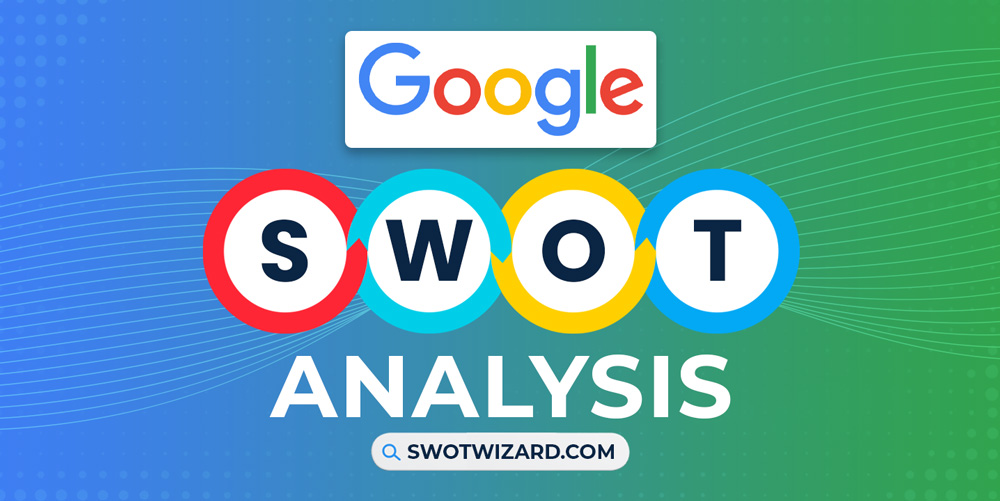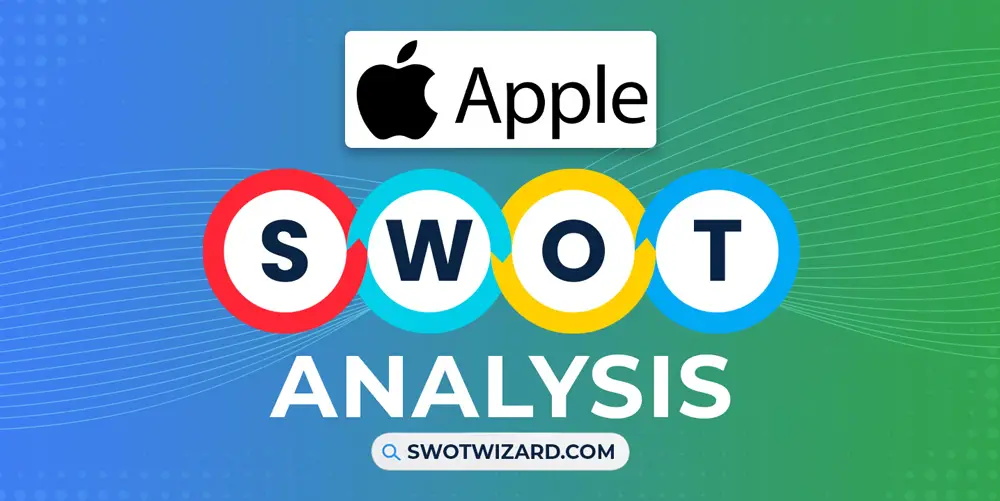Google is the world’s 2nd most valuable tech company, following closely behind Apple. Currently, it is the world’s 4th company in terms of market cap, boasting a staggering $1.180 trillion in 2023. But it is currently being threatened by a shift in the market, which we will scrutinize in this Google SWOT analysis report.
Google: Company Overview
| Company | Google LLC |
| Industry | Technology |
| Founded | 4 September, 1998 |
| Founder | Larry Page, Sergey Brin |
| CEO | Sundar Pichai |
| Headquarter | Mountain View, California, U.S. |
| No. of Employees | 139,995+ |
| Annual Revenue | $279.8 billion (FY 2022) |
| Website | google.com |
In 1995, Sergey Brin and Larry Page developed a search engine that they named Backrub. It used links to decide the priority of individual pages on the World Wide Web. In August 1998, Sun Microsystems co-founder Andy Bechtolsheim invested $100,000 into Page and Brin’s idea, creating Google Inc. The company opened its 1st office in a garage in Menlo Park, California, and operated under the motto “Don’t be evil”, which the company lost sight of with its rapid expansion from the early 2000s.
Now, Google is the world’s 2nd largest technology company, with the majority of its cash flow coming from online advertisements. It’s headquartered at 1600 Amphitheatre Parkway, Mountain View in California, and currently employs 139,995 staff. In 2022, the company generated $282.83 billion as its TTM revenue.
Product & Services of Google
Online Advertising | Search Engine Technology | Cloud Computing | Computer Software | Quantum Computing | e-Commerce | Artificial Intelligence | Consumer Electronics
Google Competitors
Bing | Yahoo | DuckDuckGo | Facebook | Amazon | Apple | Baidu | Yandex
Did You Know?
Google launched Gmail on 1 April 2004, making people suspect that the email service was an elaborate April Fools’ prank.
Strengths – Google SWOT Analysis
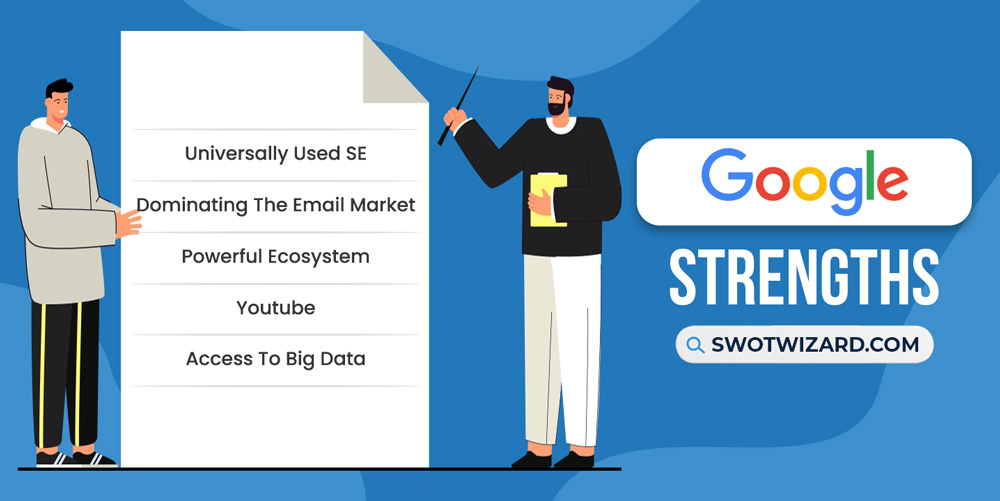
Universally Used SE: Google has become synonymous with the internet to billions of users, and from 2002 the term “Google it” became an alternate phrase for conducting web searches. In 2022, more than 9 billion Google searches were conducted by its users daily due to the company’s search engine being the default one on most web browsers. Google remains so dominant in the search engine industry that in 2022, it had a desktop market share of 84.69% and has handled over 61.7% of all US web searches to date. For mobile phones, Google’s market share comes to an overwhelming 93.56%, essentially controlling the whole market.
Dominating The Email Market: Google dominates the email market with its Gmail services, with a 36.5% market share in 2021 and a 28% market share in 2023. Gmail is a powerful email service with capabilities outstripping most competitors, and it handles 333.3 billion emails daily. It blocks more than 10 million spam and malicious emails globally per minute, and only 0.1% of the emails reaching the inbox are spam. It will also be supported in over 105 languages by 2021, which ensures over 1.5 billion users can compose and read their mail in whatever language they want.
Powerful Ecosystem: Google has created an ecosystem with all its services integrated into Gmail. A user with a Google account can sign into almost every website with a single click and access services such as Maps, Meet, Drive, Sheets, Docs, Slides, Classroom, and more. While an average desktop user can access these services, Google’s ecosystem is intended to be an Android experience. An Android user can use YouTube Music, Google Play Movie, Google Fit, and more from Google Playstore.
Youtube: In 2006, Google purchased YouTube for $1.65 billion, and this investment secured its dominance in the video streaming market. In 2020, YouTube generated a revenue of approximately $20 billion and made $19,772 as global ad revenue. YouTube Music crossed 50 million paying subscribers in 2021, and YouTube itself will have 2.1 billion users in 2023. There are no other streaming services that come close to their user count or revenue.
Access To Big Data: Through Google account user’s activity, Google collects massive amounts of user data that it can use for optimizing its ads, and provide meaningful suggestions that lead to purchases. Google can access your data through Google search engine and Google Assistant search history, Drive data, Maps location searches, Google News and Google Ads clicks, and more. Google maps collect 23.08%, YouTube 23.08%, Google Docs collects 12.82%, Google Sheets 12.82%, and Gmail collects 12.82% of the data the company gathers from its users. Due to this immense data collection, Google Ads generated $224.47 billion in revenue in 2022 and had a market share of 70.4%.
Weaknesses – Google SWOT Analysis
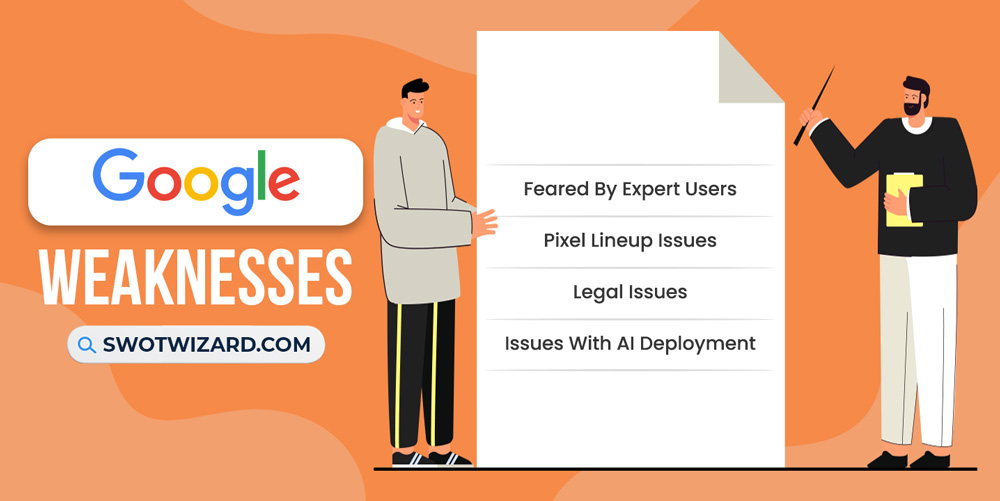
Feared By Expert Users: Google’s data-hoarding nature is perceived as threatening by expert users. Google’s data collection is considered to be extremely intrusive, as it collects twice as much data passively than from user activity. An Android with Chrome sends location data back to Google 340 times in 24 hours and scans your emails for keywords. Google was even sued in 2020 for privacy breaches seeking $5 billion, and its behavior reduces its users’ trust.
Pixel Lineup Issues: Google’s premier Android lineup Pixel has a history that is riddled with software failures and crashes. Pixel 4 had terrible battery life, lacked storage, had hardware failures, and experienced forced resets. Pixel 6 auto rejects calls, butt-dials, disconnects from the network, has security exploits, weak haptic motors, unresponsive fingerprint scanners, and Messages causing massive battery drain. Every Pixel phone has had camera issues to date, and it’s lowering Google’s chances odds of attracting more users.
Legal Issues: Google’s large market share and dominant presence has been perceived as monopolizing. On 17 December 2020, 40 lawyers sued Google for prioritizing its services in search results. In October, the US Department of Justice had already accused Google of removing competition by contracting Samsung and Apple. Governments are currently attempting to break apart Google and its parent company, Alphabet, into smaller companies.
Issues With AI Deployment: Google has been working on launching its own AI called Bard. But its development has caused a catch-22 situation for Google, as AI-powered searches essentially make Google Ads irrelevant. AI is targeted to generate exact answers and recommendations for the user, so launching Bard will remove 88% of its revenue.
Opportunities – Google SWOT Analysis

Relaunching Project Ara: Users have gradually become more interested in having control over their device hardware. Modular laptops such as Framework and smartphones such as the Pinephone have become popularized due to this trend. Google can jump into this trend by revamping and launching its Project Ara, which was supposed to produce a truly modular smartphone.
Expanding Into The Game Industry: Google already has the resources needed to invade the game industry, along with the experts needed for success. Google’s insight into consumer behavior and preferences can aid in creating high-volume sales games. Through this decision, Google can access a thriving $97.67 billion industry and dominate it.
Creating Language Teaching Services: Google can launch a language teaching service under a new brand. Google’s collection of data on language is probably the largest on the planet, and it can use it to launch a service similar to Duolingo.
Threats – Google SWOT Analysis
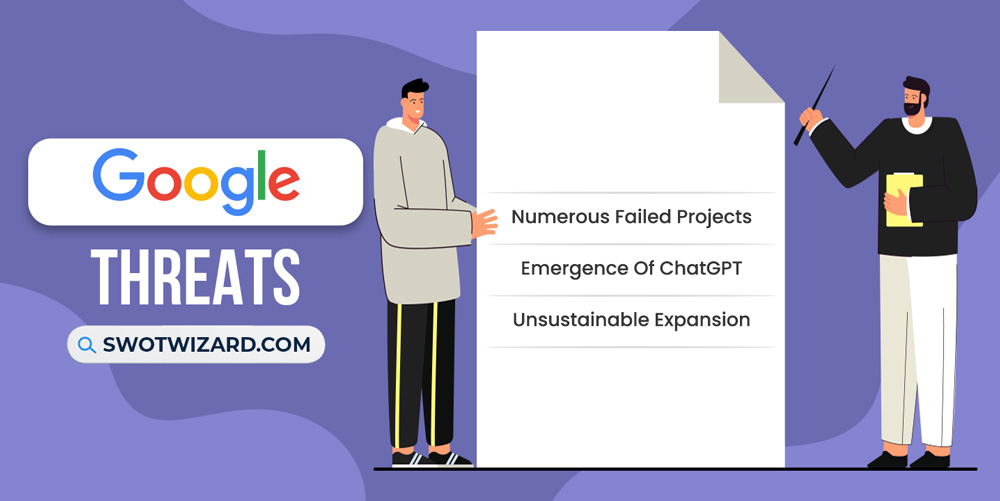
Numerous Failed Projects: Google has launched many projects in the past and continues to develop new technologies today. However, many of the projects don’t see the light of day and only cause massive loss of capital, time, and resources. The most notorious failures are Google+, Google Buzz, Project Tango, Google Answers, Google Glass, and Google Health. Continuing to fund any and every project without consideration can eventually cause the company’s capital to be depleted without any ROI.
Emergence Of ChatGPT: ChatGPT is an AI that was introduced in November 2022 by OpenAI, and it is capable of killing off Google revenue. ChatGPT can answer any question posed by the user succinctly and accurately, leaving no room to suggest products, services, or websites. It has already been integrated into Bing Search, threatening Google’s ad revenue.
Unsustainable Expansion: Like every other big technology company, Google thrived in the pandemic and grew without any consideration for the future. It had scaled too fast and ended up dropping standards, hiring in large numbers, becoming complacent, and lagging in innovation. Google didn’t manage its spontaneous growth as well as it should have and ended up having to let 12,000 of its employees go. If this behavior becomes a trend, it can lose its good employer status, market share, revenue, and identity.
[Bonus Infographic] SWOT Analysis of Google
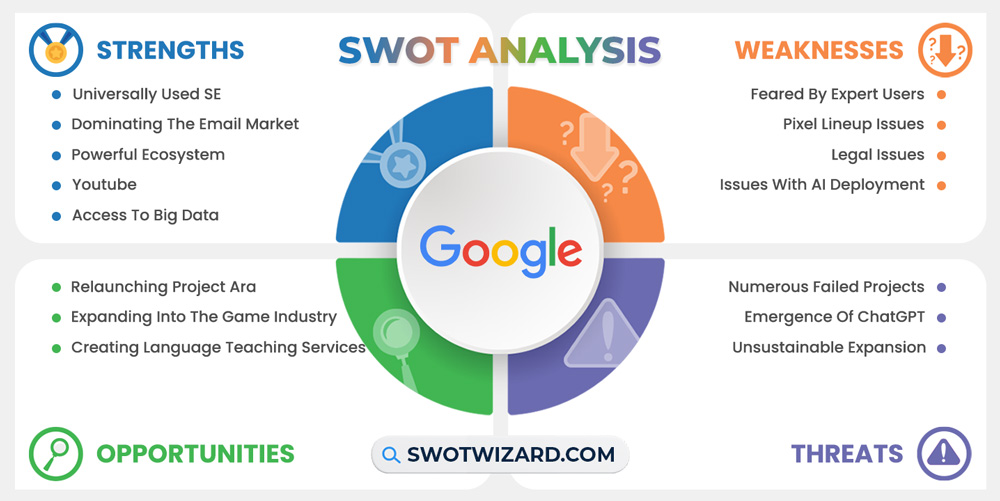
Recommendations for Google
If Google wants to sustain its market dominance, then it should consider the following suggestions.
- Google can slow down its growth and prioritize refining its scalable processes.
- The company can use its extra staff to launch legally independent brands without being accused of monopolizing the market.
- It should consider changing its operations and becoming an AI-based company.
- It should only approve research projects with higher probabilities of success.
- The company should be more forthcoming about data collection to its users.
Frequently Asked Questions (FAQs)
Does Google sell my data?
Google claims that it does not sell individual data but still processes them to generate market trends for clients.
How many web searches are processed by Google?
76% of all global web searches are processed by Google.
Final Words on Google SWOT Analysis
Google is currently the world’s 2nd most valuable technology company. However, its market dominance is coming to an end due to its revenue streams being threatened, its growing ill reputation, and unplanned expansion. To keep its position at the top, the company has to rapidly create new long-term revenue streams, hold onto its resources, and sort out accusations of monopolizing. Only then it can expect to thrive in this competitive technology market.
References
- Wikipedia contributors. (n.d.). Google LLC. Wikipedia.
- Bianchi, T. (2023, February 24). Google: advertising revenue 2022. Statista.
- Brown, C. S. (2020, May 14). The only reason the Pixel line isn’t Android’s crown jewel is Google. Android Authority.
- Chan, K. (2023, January 20). Google Axing 12,000 Jobs, As Tech Industry Layoffs Widen. HuffPost.
- Alphabet (Google) (GOOG) – Market capitalization. (n.d.). CompaniesMarketCap.
- Conger, K. (2018, May 18). Google Removes “Don’t Be Evil” Clause From Its Code of Conduct. Gizmodo.
- DeMers, J. (n.d.). 20+ Gmail Statistics to Know. EmailAnalytics.
- Downey, L. (2021, September 2). Google’s Incredible YouTube Purchase 15 Years Later. Investopedia.
- F. (2022, December 14). The 30 Biggest Failed Google Products Up To 2023. Failory.
- Garzon, J. (2015, January 15). Google’s Project Ara lets you build your own phone (hands-on pictures). CNET.
- How we started and where we are today. (n.d.). Google.
- Gray, J. (2021, February 18). Is something going on with Google Pixel cameras? Reports of failure are on the rise. DPReview.
- Heffernan, V. (2017, November 15). Just Google It: A Short History of a Newfound Verb. WIRED.
- Karim, E. (2022, February 15). Google Ecosystem Explained. Tech Journeyman.
- Email Client Market Share in 2023. (n.d.). Kinsta.
- Hicks, M. L. (2022, May 3). Pixel 6 bugs: Everything we’ve seen so far. Android Central.
- Lindsey, N. (2018, November 14). Google Data Collection Is More Extensive and Intrusive Than You Ever Imagined. CPO Magazine.
- Nieva, R., & Morse, A. (2019, December 22). Google’s three antitrust battles: Here’s what you need to know. CNET.
- Introducing ChatGPT. (2022, November 30). OpenAI.
- Ovide, S. (2021, April 30). How Big Tech Won the Pandemic. The New York Times.
- 15 Warning Signs That Show A Company Is Growing Too Fast. (2021, January 25). Forbes.
- Petrov, C. (2023, February 27). 52 Gmail Statistics To Show How Big It Is In 2023. Techjury.
- Pichai, S. (2023, February 6). An important next step on our AI journey. Google.
- Popken, B. (2018, May 10). Big-brother? Amazon, Google devices could become scary smart. NBC News.
- Johnston, M. (2022, February 26). How Google (Alphabet) Makes Money. Investopedia.
- Slynchuk, A. (2022, November 29). Big Brother Brands Report: Which Companies Access Our Personal Data the Most? Clario.
- Stempel, J. (2020, June 3). Google faces $5 billion lawsuit in U.S. for tracking “private” internet use. Reuters.
- Google buys YouTube for $1.65 billion. (2006, October 9). NBC News.
- Gosain, J. (2022, July 15). 30 Amazing Fun Facts You Never Knew About Google. TheTechToys.
- Tung, L. (2023, February 24). Microsoft: This is how we integrated ChatGPT-style tech into Bing search. ZDNET.
- Williams, L. (2021, April 30). What Kind of Data Does Google Collect? Boldist.
- Wise, J. (2022, July 21). HOW MANY GOOGLE SEARCHES PER DAY IN 2023? (FULL STATISTICS). EarthWeb.

